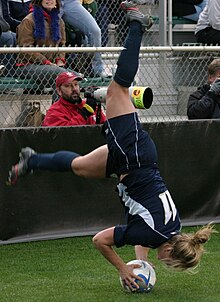Throw-in (football)
A throw-in is a measure for the continuation of play within a football game that is used when the ball leaves the field of play on a sideline. A player from the team who did not touch the ball last throws the ball back into the field of play. The throw-in is one of the so-called standard situations . The offside rule is suspended for a throw-in .
Execution of the throw-in
The throw-in is taken at the point where the ball crossed the sideline. The player must take the throw-in
- turn his face to the field,
- part of each foot touching either the sideline or the ground outside the field of play and
- throw the ball over his head from behind with both hands.
There is no rule from what distance from the field of play a throw-in may be taken. However, there must be no obstacle between the thrower and the playing field, e.g. B. stankett , gang or coach bench , in addition, it must be clearly recognizable from the process that the throw-in is to be carried out here. The ball is in play as soon as it is inside the field of play. A throw-in in which the ball does not reach the field of play or has previously touched the ground outside the field of play is deemed not to have been taken and must be repeated. If the rules are violated during a throw-in, the opposing team is awarded a throw-in.
Dispute at the throw-in
In practice, there are often disputes as to whether a throw-in was carried out in accordance with the rules. In order to reduce this, the 2016 rules made it clear that the ball should not only be held with both hands before the throw-in, but also be thrown with both hands. In particular, throw-ins should be excluded in which the second hand only serves as a support hand. Since then, the referee has primarily had to base his assessment on whether the ball was really thrown over the head from behind with both hands. If the player holds the ball too long, the throw-in is wrong in the sense of the rules, since the throw is no longer over the head. In addition, the referee must use the trajectory to judge whether it is really a throw or whether the ball has just been dropped. According to popular belief, a throw must have a certain strength and therefore overcome a distance that is not specified. Very short throw-ins are possible in accordance with the rules, but not all players have mastered this throwing technique.
Other regulations
There are also the following special features:
- As in all set pieces, the throwing-in player may not play the ball a second time until another player has touched it. If this is violated, there is an indirect free kick for the opposing team.
- All opponents must keep a minimum distance of 2 meters from the player throwing in. If this is violated, an indirect free kick for the executing team must be decided, and the player who did not keep the distance must be warned .
- There is no offside when throwing in.
- A goal cannot be scored directly from a throw-in; if the ball is thrown directly into a goal when throwing in, the goal is invalid and a goal kick (ball in the opposing team's goal) or corner kick (ball in the goal of the executing team) is decided.
physics
Textbooks have so far given 45 degrees to the horizontal as the optimal angle for throwing in, since, according to the laws of classical mechanics, projectiles - at a given speed - fly the farthest when they are thrown at a 45-degree angle. Contrary to this recommendation, however, experienced soccer players throw in at a much flatter angle in order to achieve the largest possible throw-in. As the two researchers Nicholas Linthorne and David Everett from the University of Brunel in Uxbridge have found out using biomechanical analyzes and calculations, the throw-in actually flies the furthest when it is released at an angle of around 30 degrees with a backward twist. The throwing angle is then comparatively flat, but the ball moves much faster than when throwing at an angle of 45 degrees. This is because the ball is accelerating towards the playing field for longer.
particularities

A special form of execution is the so-called somersault throw-in . The player performs with the ball in his hands a rollover , in order to achieve a higher range. This acrobatic technique is only mastered by a few actors, such as B. from the US-American Leah , the Icelander Ásta Árnadóttir or Risto Kallaste . A throw-in world record of 51.33 meters was achieved with this technique in 2010 outside a game by the Danish throw-in coach Thomas Gronnemark.
First of all, it was discussed whether this form of execution, which complies with the rules, should not be regarded as unsporting. In the meantime, however, it has been decided that this type of implementation is acceptable.
Individual evidence
- ↑ Official regulations of the German Football Association 2016/17 , PDF (2.2 MB)
- ↑ The best throwing angle when throwing in , Hamburger Abendblatt , June 20, 2008
- ↑ A shallow throw-in takes the ball further , Welt der Physik, February 3, 2006
- ↑ The unbelievable throw in by the Brazilian Leah ( page no longer available , search in web archives ) Info: The link was automatically marked as defective. Please check the link according to the instructions and then remove this notice.
- ↑ Continue to throw with Salto , nano , 3sat, June 18, 2012
- ↑ Jonno Turner: Football Challenge: The furthest throw in the world . Article from April 17, 2017 in the redbull.com portal (accessed April 16, 2018)
- ↑ Handstand, rollover, throw-in on tagesspiegel.de of December 7, 2008